
43 minute read
CLINICAL
The Power—and Peril—of Protein in the ICU
Delivering adequate protein to patients in the ICU is critical. But just how much protein to deliver, to which patients—and when—remains unclear, according to a presentation at the ASPEN20 Virtual Conference.
“Emerging data suggest that protein requirements in critical illness are probably more important than energy or kilocalorie requirements,” said presenter Todd Rice, MD, an associate professor of medicine in the Division of Allergy, Pulmonary and Critical Care Medicine at Vanderbilt University School of Medicine, in Nashville, Tenn.
Both European and U.S. guidelines suggest giving patients sufficient, high doses of protein—between 1.2 and 2 g/kg of body weight per day. Yet both guidelines grade the quality of evidence to support this practice as low. For a healthy person, about 0.8 g/kg of body weight of protein per day is generally enough to support the proper growth, mobility and synthesis of enzymes that power the biochemical reactions in the body. For an acutely ill patient in the hospital, however, protein requirements often increase.
Rice explained that protein and other macronutrients are critical for healing wounds, fighting infections and maintaining muscle and lean body mass. If critically ill patients receive
Brief Summary (For full prescribing information refer to package insert) INDICATIONS AND USAGE
EXPAREL is indicated for single-dose infiltration in adults to produce postsurgical local analgesia and as an interscalene brachial plexus nerve block to produce postsurgical regional analgesia. Limitation of Use: Safety and efficacy has not been established in other nerve blocks.
CONTRAINDICATIONS
EXPAREL is contraindicated in obstetrical paracervical block anesthesia. While EXPAREL has not been tested with this technique, the use of bupivacaine HCl with this technique has resulted in fetal bradycardia and death.
WARNINGS AND PRECAUTIONS Warnings and Precautions Specific for EXPAREL
As there is a potential risk of severe life-threatening adverse effects associated with the administration of bupivacaine, EXPAREL should be administered in a setting where trained personnel and equipment are available to promptly treat patients who show evidence of neurological or cardiac toxicity. Caution should be taken to avoid accidental intravascular injection of EXPAREL. Convulsions and cardiac arrest have occurred following accidental intravascular injection of bupivacaine and other amide-containing products. Avoid additional use of local anesthetics within 96 hours following administration of EXPAREL. EXPAREL has not been evaluated for the following uses and, therefore, is not recommended for these types of analgesia or routes of administration. • epidural • intrathecal • regional nerve blocks other than interscalene brachial plexus nerve block • intravascular or intra-articular use EXPAREL has not been evaluated for use in the following patient population and, therefore, it is not recommended for administration to these groups. • patients younger than 18 years old • pregnant patients The potential sensory and/or motor loss with EXPAREL is temporary and varies in degree and duration depending on the site of injection and dosage administered and may last for up to 5 days as seen in clinical trials.
ADVERSE REACTIONS Clinical Trial Experience
Adverse Reactions Reported in Local Infiltration Clinical Studies The safety of EXPAREL was evaluated in 10 randomized, double-blind, local administration into the surgical site clinical studies involving 823 patients undergoing various surgical procedures. Patients were administered a dose ranging from 66 to 532 mg of EXPAREL. In these studies, the most common adverse reactions (incidence greater than or equal to 10%) following EXPAREL administration were nausea, constipation, and vomiting. The common adverse reactions (incidence greater than or equal to 2% to less than 10%) following EXPAREL administration were pyrexia, dizziness, edema peripheral, anemia, hypotension, pruritus, tachycardia, headache, insomnia, anemia postoperative, muscle spasms, hemorrhagic anemia, back pain, somnolence, and procedural pain. Adverse Reactions Reported in Nerve Block Clinical Studies The safety of EXPAREL was evaluated in four randomized, double-blind, placebo- controlled nerve block clinical studies involving 469 patients undergoing various surgical procedures. Patients were administered a dose of either 133 or 266 mg of EXPAREL. In these studies, the most common adverse reactions (incidence greater than or equal to 10%) following EXPAREL administration were nausea, pyrexia, and constipation. The common adverse reactions (incidence greater than or equal to 2% to less than 10%) following EXPAREL administration as a nerve block were muscle twitching, dysgeusia, urinary retention, fatigue, headache, confusional state, hypotension, hypertension, hypoesthesia oral, pruritus generalized, hyperhidrosis, tachycardia, sinus tachycardia, anxiety, fall, body temperature increased, edema peripheral, sensory loss, hepatic enzyme increased, hiccups, hypoxia, post-procedural hematoma. Postmarketing Experience These adverse reactions are consistent with those observed in clinical studies and most commonly involve the following system organ classes (SOCs): Injury, Poisoning, and Procedural Complications (e.g., drug-drug interaction, procedural pain), Nervous System Disorders (e.g., palsy, seizure), General Disorders And Administration Site Conditions (e.g., lack of efficacy, pain), Skin and Subcutaneous Tissue Disorders (e.g., erythema, rash), and Cardiac Disorders (e.g., bradycardia, cardiac arrest).
DRUG INTERACTIONS
The toxic effects of local anesthetics are additive and their co-administration should be used with caution including monitoring for neurologic and cardiovascular effects related to local anesthetic systemic toxicity. Avoid additional use of local anesthetics within 96 hours following administration of EXPAREL. Patients who are administered local anesthetics may be at increased risk of developing methemoglobinemia when concurrently exposed to the following drugs, which could include other local anesthetics:
Examples of Drugs Associated with Methemoglobinemia:
Class Examples
Nitrates/Nitrites nitric oxide, nitroglycerin, nitroprusside, nitrous oxide
Local anesthetics articaine, benzocaine, bupivacaine, lidocaine, mepivacaine, prilocaine, procaine, ropivacaine, tetracaine
Antineoplastic cyclophosphamide, flutamide, hydroxyurea, ifosfamide, agents rasburicase
Antibiotics dapsone, nitrofurantoin, para-aminosalicylic acid, sulfonamides
Antimalarials chloroquine, primaquine
Anticonvulsants Phenobarbital, phenytoin, sodium valproate
Other drugs acetaminophen, metoclopramide, quinine, sulfasalazine Bupivacaine Bupivacaine HCl administered together with EXPAREL may impact the pharmacokinetic and/or physicochemical properties of EXPAREL, and this effect is concentration dependent. Therefore, bupivacaine HCl and EXPAREL may be administered simultaneously in the same syringe, and bupivacaine HCl may be injected immediately before EXPAREL as long as the ratio of the milligram dose of bupivacaine HCl solution to EXPAREL does not exceed 1:2. Non-bupivacaine Local Anesthetics EXPAREL should not be admixed with local anesthetics other than bupivacaine. Nonbupivacaine based local anesthetics, including lidocaine, may cause an immediate release of bupivacaine from EXPAREL if administered together locally. The administration of EXPAREL may follow the administration of lidocaine after a delay of 20 minutes or more. There are no data to support administration of other local anesthetics prior to administration of EXPAREL. Other than bupivacaine as noted above, EXPAREL should not be admixed with other drugs prior to administration. Water and Hypotonic Agents Do not dilute EXPAREL with water or other hypotonic agents, as it will result in disruption of the liposomal particles
USE IN SPECIFIC POPULATIONS Pregnancy
Risk Summary There are no studies conducted with EXPAREL in pregnant women. In animal reproduction studies, embryo-fetal deaths were observed with subcutaneous administration of bupivacaine to rabbits during organogenesis at a dose equivalent to 1.6 times the maximum recommended human dose (MRHD) of 266 mg. Subcutaneous administration of bupivacaine to rats from implantation through weaning produced decreased pup survival at a dose equivalent to 1.5 times the MRHD [see Data]. Based on animal data, advise pregnant women of the potential risks to a fetus. The background risk of major birth defects and miscarriage for the indicated population is unknown. However, the background risk in the U.S. general population of major birth defects is 2-4% and of miscarriage is 15-20% of clinically recognized pregnancies. Clinical Considerations Labor or Delivery Bupivacaine is contraindicated for obstetrical paracervical block anesthesia. While EXPAREL has not been studied with this technique, the use of bupivacaine for obstetrical paracervical block anesthesia has resulted in fetal bradycardia and death. Bupivacaine can rapidly cross the placenta, and when used for epidural, caudal, or pudendal block anesthesia, can cause varying degrees of maternal, fetal, and neonatal toxicity. The incidence and degree of toxicity depend upon the procedure performed, the type, and amount of drug used, and the technique of drug administration. Adverse reactions in the parturient, fetus, and neonate involve alterations of the central nervous system, peripheral vascular tone, and cardiac function. Data Animal Data Bupivacaine hydrochloride was administered subcutaneously to rats and rabbits during the period of organogenesis (implantation to closure of the hard plate). Rat doses were 4.4, 13.3, and 40 mg/kg/day (equivalent to 0.2, 0.5 and 1.5 times the MRHD, respectively, based on the BSA comparisons and a 60 kg human weight) and rabbit doses were 1.3, 5.8, and 22.2 mg/kg/day (equivalent to 0.1, 0.4 and 1.6 times the MRHD, respectively, based on the BSA comparisons and a 60 kg human weight). No embryo-fetal effects were observed in rats at the doses tested with the high dose causing increased maternal lethality. An increase in embryo-fetal deaths was observed in rabbits at the high dose in the absence of maternal toxicity. Decreased pup survival was noted at 1.5 times the MRHD in a rat pre- and post-natal development study when pregnant animals were administered subcutaneous doses of 4.4, 13.3, and 40 mg/kg/day buprenorphine hydrochloride (equivalent to 0.2, 0.5 and 1.5 times the MRHD, respectively, based on the BSA comparisons and a 60 kg human weight) from implantation through weaning (during pregnancy and lactation).
Lactation
Risk Summary Limited published literature reports that bupivacaine and its metabolite, pipecoloxylidide, are present in human milk at low levels. There is no available information on effects of the drug in the breastfed infant or effects of the drug on milk production. The developmental and health benefits of breastfeeding should be considered along with the mother’s clinical need for EXPAREL and any potential adverse effects on the breastfed infant from EXPAREL or from the underlying maternal condition.
Pediatric Use
Safety and effectiveness in pediatric patients have not been established.
Geriatric Use
Of the total number of patients in the EXPAREL local infiltration clinical studies (N=823), 171 patients were greater than or equal to 65 years of age and 47 patients were greater than or equal to 75 years of age. Of the total number of patients in the EXPAREL nerve block clinical studies (N=531), 241 patients were greater than or equal to 65 years of age and 60 patients were greater than or equal to 75 years of age. No overall differences in safety or effectiveness were observed between these patients and younger patients. Clinical experience with EXPAREL has not identified differences in efficacy or safety between elderly and younger patients, but greater sensitivity of some older individuals cannot be ruled out.
Hepatic Impairment
Amide-type local anesthetics, such as bupivacaine, are metabolized by the liver. Patients with severe hepatic disease, because of their inability to metabolize local anesthetics normally, are at a greater risk of developing toxic plasma concentrations, and potentially local anesthetic systemic toxicity. Therefore, consider increased monitoring for local anesthetic systemic toxicity in subjects with moderate to severe hepatic disease.
Renal Impairment
Bupivacaine is known to be substantially excreted by the kidney, and the risk of toxic reactions to this drug may be greater in patients with impaired renal function. This should be considered when performing dose selection of EXPAREL.
OVERDOSAGE
Clinical Presentation Acute emergencies from local anesthetics are generally related to high plasma concentrations encountered during therapeutic use of local anesthetics or to unintended intravascular injection of local anesthetic solution. Signs and symptoms of overdose include CNS symptoms (perioral paresthesia, dizziness, dysarthria, confusion, mental obtundation, sensory and visual disturbances and eventually convulsions) and cardiovascular effects (that range from hypertension and tachycardia to myocardial depression, hypotension, bradycardia and asystole). Plasma levels of bupivacaine associated with toxicity can vary. Although concentrations of 2,500 to 4,000 ng/mL have been reported to elicit early subjective CNS symptoms of bupivacaine toxicity, symptoms of toxicity have been reported at levels as low as 800 ng/mL. Management of Local Anesthetic Overdose At the first sign of change, oxygen should be administered. The first step in the management of convulsions, as well as underventilation or apnea, consists of immediate attention to the maintenance of a patent airway and assisted or controlled ventilation with oxygen and a delivery system capable of permitting immediate positive airway pressure by mask. Immediately after the institution of these ventilatory measures, the adequacy of the circulation should be evaluated, keeping in mind that drugs used to treat convulsions sometimes depress the circulation when administered intravenously. Should convulsions persist despite adequate respiratory support, and if the status of the circulation permits, small increments of an ultra-short acting barbiturate (such as thiopental or thiamylal) or a benzodiazepine (such as diazepam) may be administered intravenously. The clinician should be familiar, prior to the use of anesthetics, with these anticonvulsant drugs. Supportive treatment of circulatory depression may require administration of intravenous fluids and, when appropriate, a vasopressor dictated by the clinical situation (such as ephedrine to enhance myocardial contractile force). If not treated immediately, both convulsions and cardiovascular depression can result in hypoxia, acidosis, bradycardia, arrhythmias and cardiac arrest. If cardiac arrest should occur, standard cardiopulmonary resuscitative measures should be instituted. Endotracheal intubation, employing drugs and techniques familiar to the clinician, maybe indicated, after initial administration of oxygen by mask, if difficulty is encountered in the maintenance of a patent airway or if prolonged ventilatory support (assisted or controlled) is indicated.
DOSAGE AND ADMINISTRATION Important Dosage and Administration Information
• EXPAREL is intended for single-dose administration only. • Different formulations of bupivacaine are not bioequivalent even if the milligram strength is the same. Therefore, it is not possible to convert dosing from any other formulations of bupivacaine to EXPAREL. • DO NOT dilute EXPAREL with water for injection or other hypotonic agents, as it will result in disruption of the liposomal particles. • Use suspensions of EXPAREL diluted with preservative-free normal (0.9%) saline for injection or lactated Ringer’s solution within 4 hours of preparation in a syringe. • Do not administer EXPAREL if it is suspected that the vial has been frozen or exposed to high temperature (greater than 40°C or 104°F) for an extended period. • Inspect EXPAREL visually for particulate matter and discoloration prior to administration, whenever solution and container permit. Do not administer EXPAREL if the product is discolored.
Recommended Dosing in Adults
Local Analgesia via Infiltration The recommended dose of EXPAREL for local infiltration in adults is up to a maximum dose of 266mg (20 mL), and is based on the following factors: • Size of the surgical site • Volume required to cover the area • Individual patient factors that may impact the safety of an amide local anesthetic As general guidance in selecting the proper dosing, two examples of infiltration dosing are provided: • In patients undergoing bunionectomy, a total of 106 mg (8 mL) of EXPAREL was administered with 7 mL infiltrated into the tissues surrounding the osteotomy, and 1 mL infiltrated into the subcutaneous tissue. • In patients undergoing hemorrhoidectomy, a total of 266 mg (20 mL) of EXPAREL was diluted with 10 mL of saline, for a total of 30 mL, divided into six 5 mL aliquots, injected by visualizing the anal sphincter as a clock face and slowly infiltrating one aliquot to each of the even numbers to produce a field block. Regional Analgesia via Interscalene Brachial Plexus Nerve Block The recommended dose of EXPAREL for interscalene brachial plexus nerve block in adults is 133 mg (10 mL), and is based upon one study of patients undergoing either total shoulder arthroplasty or rotator cuff repair.
Compatibility Considerations
Admixing EXPAREL with drugs other than bupivacaine HCl prior to administration is not recommended. • Non-bupivacaine based local anesthetics, including lidocaine, may cause an immediate release of bupivacaine from EXPAREL if administered together locally. The administration of EXPAREL may follow the administration of lidocaine after a delay of 20 minutes or more. • Bupivacaine HCl administered together with EXPAREL may impact the pharmacokinetic and/or physicochemical properties of EXPAREL, and this effect is concentration dependent. Therefore, bupivacaine HCl and EXPAREL may be administered simultaneously in the same syringe, and bupivacaine HCl may be injected immediately before EXPAREL as long as the ratio of the milligram dose of bupivacaine HCl solution to EXPAREL does not exceed 1:2. The toxic effects of these drugs are additive and their administration should be used with caution including monitoring for neurologic and cardiovascular effects related to local anesthetic systemic toxicity. • When a topical antiseptic such as povidone iodine (e.g., Betadine®) is applied, the site should be allowed to dry before EXPAREL is administered into the surgical site. EXPAREL should not be allowed to come into contact with antiseptics such as povidone iodine in solution. Studies conducted with EXPAREL demonstrated that the most common implantable materials (polypropylene, PTFE, silicone, stainless steel, and titanium) are not affected by the presence of EXPAREL any more than they are by saline. None of the materials studied had an adverse effect on EXPAREL.
Non-Interchangeability with Other Formulations of Bupivacaine
Different formulations of bupivacaine are not bioequivalent even if the milligram dosage is the same. Therefore, it is not possible to convert dosing from any other formulations of bupivacaine to EXPAREL and vice versa. Liposomal encapsulation or incorporation in a lipid complex can substantially affect a drug’s functional properties relative to those of the unencapsulated or nonlipid-associated drug. In addition, different liposomal or lipid-complexed products with a common active ingredient may vary from one another in the chemical composition and physical form of the lipid component. Such differences may affect functional properties of these drug products. Do not substitute.
CLINICAL PHARMACOLOGY Pharmacokinetics
Administration of EXPAREL results in significant systemic plasma levels of bupivacaine which can persist for 96 hours after local infiltration and 120 hours after interscalene brachial plexus nerve block. In general, peripheral nerve blocks have shown systemic plasma levels of bupivacaine for extended duration when compared to local infiltration. Systemic plasma levels of bupivacaine following administration of EXPAREL are not correlated with local efficacy.
PATIENT COUNSELING
Inform patients that use of local anesthetics may cause methemoglobinemia, a serious condition that must be treated promptly. Advise patients or caregivers to seek immediate medical attention if they or someone in their care experience the following signs or symptoms: pale, gray, or blue colored skin (cyanosis); headache; rapid heart rate; shortness of breath; lightheadedness; or fatigue. inadequate protein for a significant period, they may have greater difficulty in recovering from illness and may face major functional declines during and after hospitalization.
Recent observational studies have found reduced mortality for ICU patients with the delivery of between 1.2 and 1.5 g/kg of body weight per day (J Parenter Enteral Nutr 2012;36[1]:6068; Crit Care 2014;18[6]:701); better outcomes for ventilated ICU patients who receive more than 90% of target protein (Crit Care 2016;20[1]:386); and a decrease of 6.6% in the odds of death for every 10% increase in protein delivered to an ICU patient (Crit Care Med 2017;45[2]:156-163). Another study found a gain of 1% in survival for each additional gram per kilogram of body weight per day of protein delivered (Crit Care 2016;20[1]:367).
But the protein-to-outcomes relationship is not necessarily linear, nor black and white. Observational trials can mislead due to confounding issues. For example, patients in a study who are not as sick may be better able to tolerate greater quantities of calories and protein compared with sicker patients. “Maybe it’s not the protein or calories but the fact that they are less sick,” Rice said.
Randomized controlled trials remove many of the biases. Yet the results of these trials on protein delivery in the ICU have so far been “all over the map,” he said. “They have shown things like higher protein improving creatinine clearance. But we have not been able to show that protein delivery in randomized trials improves mortality.”
In fact, one study found that delivering full protein actually might be detrimental, reducing the chance of an ICU patient being discharged alive (odds ratio [OR], 0.92 on day 3; P<0.05). However, the study found that this risk resolved after day 7 (Am J Respir Crit Care Med 2013;187[3]:247-255).
“All of the trials have some deficiencies and some flaws, and that may be part of the reason that we don’t see a huge signal here,” Rice said.
A Patient-Driven Approach
A closer look at the randomized data begins to uncover somewhat stronger signals. The evidence suggests that the amount of protein that proves beneficial may vary between patients as well as over the course of a patient’s illness. “There are different protein requirements for different populations and in different settings,” Rice said.
The odds of survival for a septic patient, for example, may be increased with a moderate amount of protein, not with the highest level, according to one study
There was a decrease of 6.6% in the odds of death for every 10% increase in protein delivered to an ICU patient
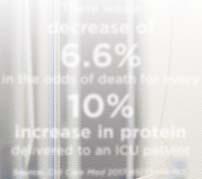
Source: Crit Care Med 2017;45[2]:156-163.
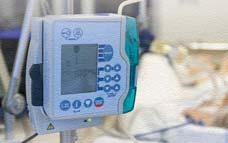
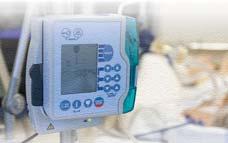
(Clin Nutr 2019;38[2]:883-890). Another study found that during the acute phase of illness—usually the first few days—it may be best not to deliver high amounts of protein. Instead, protein delivery should be ramped up to goal during the stabilization phase, which is usually between days 4 and 7. Then, during the recovery and rehab phases, protein delivery up to 1.5 or 2 g/kg of body weight 2019;38[1]:48-79).
Rice cautioned that it is unlikely the duration of these phases would be the same for all patients or occur on similar days of their illness. In some patients, the acute phase may last just two days or could extend to six days, he explained, adding, “We need to better investigate markers that indicate a patient has transitioned from the acute to the subacute or chronic or rehabilitation phase.”
Moreover, “to reach protein requirements, we often have to use protein supplements,” Rice said. “Two grams is a lot of protein. You don’t get that with the administration of normal daily volumes of standard formulas.”
New Formulas Hold Promise
However, new formulas in development, such as a very high intact-protein formula (VHPF) for enteral feeding used in one clinical trial, promise to deliver more protein without higher amounts of calories that could put a patient at risk for overfeeding. In the study, the investigators compared a VHPF (8 g protein/100 kcal; 32% of energy) tube feed (1.25 kcal/mL) with standard enteral feeding (Crit Care 2018;22[1]:156). Protein intake at day 5 was significantly higher in the VHPF group (1.49 g/kg adjusted body weight [ABW] per day; 95% CI, 1.21-1.78 g/kg) than in the standard enteral feeding group (0.76 g/kg ABW per day; 95% CI, 0.49-1.03 g/kg), with a difference of 0.73 g/kg
“We need to rigorously study these formulas to understand their effects on critically ill patients,” Rice said.
Rice pointed to one potential complication that could add to an already challenging issue. Critical illness and disease put the human body into a highly catabolic state, resulting in a significant breakdown of protein and rapid losses of muscle and organ mass. “So just providing more protein may not overcome all this protein degradation [or proteolysis],” Rice explained. “Maybe we need to add something with this protein, such as resistant exercise to help the body use it.”
As for current tips, “it’s pretty clear that the old practice of restricting protein in patients with renal or hepatic failure needs to be stopped. And we should increase protein for patients with burns or other trauma, as well as those on continuous renal replacement therapy or extracorporeal membrane oxygenation (ECMO),” he said, noting the potential relevance for COVID-19 patients on ECMO (J Parenter Enteral Nutr 2016;40[2]:159-211).
The Pharmacist’s Role
Jacob Hall, PharmD, BCNSP, a clinical pharmacy specialist at The University of Texas MD Anderson Cancer Center, in Houston, who was not involved in the session, emphasized the role pharmacists can play in providing protein as a “lowrisk to high-benefit ratio intervention.
“As clinical pharmacists in the ICU,” Hall said, “we should evaluate protein doses in our patients [and ensure] the correct dose to optimize outcomes, similar to how we work to optimize
Rice is a consultant to Baxter and Nestlé. Hall reported no relevant fi nancial relationships.
per day may improve outcomes (Clin Nutr
ABW per day (P<0.001).
medication dosing.” —Lynne Peeples
Don’t miss a single issue… Renew Today!


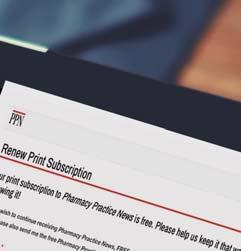






PharmacyPracticeNews.com/ RenewSubscription
Small Trial Looks at Anticoag Dosing for COVID-19 Patients
In patients with severe COVID-19, therapeutic doses of enoxaparin improved gas exchange and decreased the need for mechanical ventilation compared with standard thromboprophylaxis in the phase 2 HESACOVID trial, the first prospective, randomized controlled trial in this setting.
In the trial, Lemos et al randomly assigned patients with COVID-19 who required mechanical ventilation to receive enoxaparin (n=10) or standard anticoagulant thromboprophylaxis (n=10) (Thromb Res 2020 Sep 20. [Epub ahead of print]). The enoxaparin group received subcutaneous enoxaparin dosed according to age and adjusted daily by creatinine clearance (maximum dose, 140 mg twice daily). The standard thromboprophylaxis group received physician’s choice of subcutaneous unfractionated heparin (5,000 IU three times daily for patients <120 kg; 7,500 IU three times daily for patients >120 kg) or enoxaparin (40 mg once daily for patients <120 kg; 40 mg twice daily for patients >120 kg).
The investigators evaluated gas exchange using the ratio of partial pressure of arterial oxygen (PaO2) to the fraction of inspired oxygen (FiO2) at baseline, and seven and 14 days after randomization, as well as the time to successful weaning from mechanical ventilation and the number of ventilator-free days.
The investigators found a significant increase in the PaO2/FiO2 ratio over time in the therapeutic group, from 163 (95% CI, 133-193) at baseline, to 209 (95% CI, 171-247) after seven days and 261 (95% CI, 230-293) after 14 days (P=0.0004). They did not observe an improvement in the prophylactic group, which had a gas exchange ratio of 184 (95% CI, 146-222) at baseline, 168 (95% CI, 142-195) after seven days, and 195 (95% CI, 128-262) after 14 days (P=0.487).
Patients in the therapeutic group also were more likely to be weaned from mechanical ventilation (hazard ratio, 4.0; 95% CI, 1.035-15.053; P=0.031) and had more ventilator-free days compared with the prophylactic group (15 days; interquartile range [IQR], 6-16 days vs. 0 days; IQR, 0–11 days; P=0.028).
Commenting on the study, Ralph J. Riello III, PharmD, a clinical pharmacy

specialist in the cardiac ICU at Yale New Haven Hospital, in Connecticut, said it provided “an eagerly anticipated first peek at a pivotal clinical question that all front-line health care providers managing COVID-19 patients are facing: Is a higher intensity of prophylactic anticoagulation warranted to combat the significantly elevated risk of venous and arterial thrombotic events in coronavirus patients?”
Although the generalizability of the results is “limited by the study’s singlecenter, open-label design and small sample size,” Riello said he is “encouraged by the positive findings with respect to better pulmonary gas exchange and, especially, improved duration of mechanical ventilation and more successful extubation attempts,” both of which he considered to be “more clinically relevant outcomes than PaO2/FiO2 ratio.” He also pointed to the trend toward fewer ICU days as an important finding, although noting that “this difference narrowly missed statistical significance (P=0.067).”
A “disappointing omission of the study,” Riello said, was the lack of inclusion of D-dimer to stratify the risk for thrombosis and “provide more justification for therapeutic intensity anticoagulation.” He explained that D-dimer “is a wellvalidated laboratory biomarker that we employ across Yale New Haven Health System to better understand an individual coronavirus patient’s thrombosis risk and provide adequately dosed anticoagulation treatment. D-dimer has already been shown to correlate well with disease severity and even reliably predicts mortality in hospitalized COVID-19 patients” (Lancet 2020; 395[10229]:1054-1062). (See “Countering COVID-19’s Thromboinflammation,” page 4).
Although HESACOVID was not powered to find differences in outcomes such as thrombosis, bleeding or mortality, Riello said it is “important to note that there were no concerning signals to suggest that therapeutic intensity anticoagulation confers any harm and at least an inkling that there may be a clinical benefit for respiratory function. This is especially important, as empirically anticoagulating patients at full therapeutic doses of enoxaparin without the presence of a confirmed acute blood clot may give clinicians pause for concern due to increased bleeding risk.” —Sarah Tilyou
Q & A
The following advertorial is provided by Medi-Dose. It is designed to support the adjacent advertisement.
MPB - Multi-Purpose Blisters
Q: For over 45 years your MediDose solid oral blisters have been instrumental to the adoption of unit dose and bedside bar coding. How has a product that seems so simple adapted to the constant evolution in the practice of pharmacy over the years?
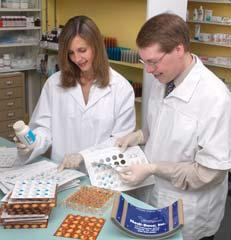
A: From the start, this company was built on our close relationships with pharmacists and pharmacy staff. Our products are the results of conversations with these professionals about the challenges they face when balancing their goal to provide safe, effective treatments for their patients with the always-present pressure to control costs. When new innovations, such as bedside bar coding, or new standards, such as USP <800>, require sweeping changes to the way medications are packaged and handled, their input has been essential in helping us quickly refine and improve our products to navigate and meet these new requirements. There are so many moving parts in a modern pharmacy setting. The expectations and challenges are constantly shifting, making an economical, easy to use, adaptable system such as Medi-Dose so important to the smooth operation of your practice.
Q: What changes has Medi-Dose made in response to the new USP <800> recommendations?
A: As a manual system requiring no machinery, thereby reducing the risk of cross-contamination, Medi-Dose is well positioned to mitigate many of the issues that standards like USP <800> address regarding the safe handling of hazardous medications. In addition, free updates to our MILT software bring awareness of these issues to the attention of pharmacy staff. So now, we have been focused on extending the ability of our industry leading packaging solutions to secure even more sizes and types of medications by introducing a dramatically larger blister.
Q: How does a larger blister help?
A: In addition to traditional unit dose packaging, there are numerous medication forms and types of packaging required of pharmacy. We designed the MPB™ (Multi-Purpose Blister) to accommodate these special items and situations, such as oversized tablets, unit-of-use packaging, suppositories, compounded medications and even items already packaged in unit dose but not bar coded or labeled correctly for your practice.
Q: So, the MPB is like your current blisters, only larger?
A: We used the same materials for the blisters and labels because they have been shown to be stable and trustworthy through many years of field experience in countless environments. These materials create a package that is resilient, tamper evident, moisture resistant and UV light inhibitant without the need for machinery or heat sealers. The two new sizes, 5/8” deep and 1-1/4” deep, both have a well that is 1-1/2” square and a printing area that is 2” square. This balances the room needed for clear labeling of the blister’s contents against the space required to store it in most dispensing cabinets. As always, comments and suggestions from customers were incorporated into the design of the MPB to improve the user experience with the product.
Q: Is it expensive or difficult to introduce the MPB into my practice?
A: Not at all. If you are already using our MILT 4 software, there is a free update on our web site that adds the new label format. You would only need a Fil-Form template, the blisters and labels. If you are new to Medi-Dose, a free demo of MILT 4 can be downloaded from our web site. New customers can be ready to package their medication for under a thousand dollars, with no capital expense required.
Adapting a Meds-to-Beds Program to COVID-19
By Jennifer Hillman, MBA, PharmD
Director of Pharmacy Department of Pharmacotherapy and Pharmacy Services University Hospital San Antonio, Texas
Introduction
University Hospital, located in San Antonio, Texas, is a Level 1 trauma, academic medical center that serves 22 counties in the South Texas region. The hospital is licensed for approximately 700 beds and is comprised of 3 free-standing, high-rise towers. In 2018, the hospital initiated a meds-to-beds program that has proved extremely successful, increasing the monthly prescriptions dispensed from the discharge pharmacy from 3,000 to more than 15,000 per month. Since the COVID-19 pandemic began, several modifications have been made to allow staff to continue to serve patients in the program. This article shares these innovations with other health-system pharmacies to ensure patient access to discharge medications despite the ongoing COVID-19 pandemic.
Strategic Location
The meds-to-beds program was started using the discharge pharmacy located on the first floor in the south end of the hospital. This location is significantly far from the main 10-story Sky tower on the north side of the hospital, where more than 50% of hospitalized patients are admitted. At its farthest point, it can take up to 12 minutes for staff to travel from the pharmacy to the top floor of the Sky tower. To reduce the travel time between the discharge pharmacy and the patient bedside, the pharmacy opened a second meds-to-beds location in the main Sky tower. This new meds-to-beds, closeddoor pharmacy is strategically positioned on and between the highest-volume discharging floors. The close proximity of the pharmacy to patients enables the meds-to-beds technician to use either the elevators or stairs, thereby reducing travel between deliveries and increasing efficiency. The second location, focused exclusively on meds-to-beds patients, reduced phone calls and eliminated front counter distractions.
Because the meds-to-beds operation is a closed-door pharmacy, there is no risk for infection transmission from patient contact. The pharmacy department split the staff to keep a team of members who were unexposed to patients in the meds-to-beds operation. In the event of an outbreak of COVID-19 among the

discharge pharmacy staff, a team of segregated pharmacy staff is available to keep the operation functioning.
Patient Consent
Meds-to-beds programs require patients to voluntarily fill prescriptions using the hospital pharmacy. Pharmacy staff explain the basic components of the program to patients in their hospital rooms. If the patient is interested, technicians obtain the patient’s consenting signature. Since the pandemic began, admitted patients who were designated as COVID-19-positive or under investigation for possible COVID-19 are asked to participate in the meds-to-beds program using a revised method. Technicians still approach the patient room; however, instead of entering, the technicians stop at the observation window. They call the patient’s hospital room telephone from their cleanable mobile phone. The observation window allows the patient to see the meds-to-beds pharmacy technician while maintaining a safe barrier. Technicians sign the consent form on behalf of the patient and note “verbal approval obtained COVID.” Using this adapted method, the department has been able to maintain enrollment rates. A secondary benefit of this modified approach is the conservation of personal protective equipment, which at times has been a limited resource.
Prescription Transmissions
Prior to COVID-19, prescription submission to the meds-to-beds program was
see MEDS-TO-BEDS, page 16
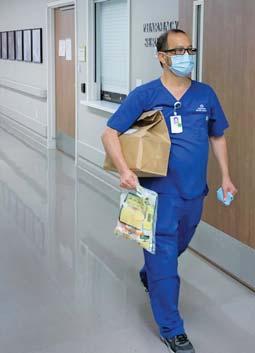


MEDS-TO-BEDS
continued from page 14
accomplished primarily through printed paper prescriptions. Paper prescriptions were picked up several times per day on the hospital floors by the meds-to-beds technicians and hand delivered to the discharge pharmacy. With the onset of COVID-19, the health system encouraged providers to use the electronic prescription submission functionality. As a result, electronic prescription rates increased to the current rate of 90%. Electronic prescriptions have reduced staff exposure to potential infection via time spent on the floors and touch contamination.
The pharmacy department has requested that discharge prescription transmission occur as early as possible, including up to a day before anticipated discharge. The purpose of the request is to expedite prescription processing, with the goal of preventing patients from remaining on the hospital floor to wait for their medications or relocating to the hospital transitional unit, pharmacy lobby or hospital lobby to wait. If providers are not certain about a particular medication for discharge but are sure about others, the pharmacy will fill 100% of the confirmed prescriptions and hold processing those that are being reconciled until final discharge. Filled prescriptions awaiting delivery are kept in the meds-to-beds pharmacy until the discharge is confirmed.
Pharmacy Lobby Modifications
The discharge pharmacy lobby was originally designed with densely packed seating. The pandemic necessitated
Product Differentiation at First Sight
DESIGN
Every product family has a unique coordinating label and carton design.
STORAGE OPTIONS
Drug name and strength are printed on both sides of bag overwraps, making them easier to identify no matter e how they are stored.
SIZE
Product name and strength are prominent on labels and cartons.

FLEXIBILITY
Offering both presentations encourages flexibility to achieve desired strength and reduce product waste.
All SAGENT® products feature the benefits of PreventIV Measures® Packaging and Labeling. Multiple layers of differentiation help make drug selection an easy and obvious choice every time.
To learn more, visit www.PreventIVMeasures.com.
removal of over half the chairs to create at least 6 feet of distance between each patient. Social distancing floor demarcations were installed in the lobby and the exterior hallway leading to the lobby, directing patients to physically distance themselves in a safe manner. Hand-sanitizing stations were mounted in the pharmacy lobby, and clear plexiglass barriers were installed in prescription dropoff and pick-up areas.
Pharmacy staff monitor the pharmacy lobby and proactively intervene if the lobby becomes noticeably full. Staff members triage patients in line. If prescriptions are not urgent, staff ask the patient if they would accept prescriptions for mail or same-day courier. This strategy has been effective in reducing the number of patients congregating in a small space.
Alternate Delivery Methods
The emergency department (ED) is serviced by the meds-to-beds program. This area is known to have a higher percentage of suspected and confirmed COVID-19 patients. To minimize the risk for exposure to the virus, the medsto-beds program has elected to use the pneumatic tube system to deliver medications to the ED instead of hand delivering to the bedside. A single tube station within the ED is designated for discharge medications. The nurse providing care to the patient retrieves the medicines from the designated pneumatic tube system and dispenses them to the patient.
Payment Transactions
Patients retrieving prescriptions at the discharge pharmacy pay at the front counter. To reduce the transaction time at the pharmacy window and touch contamination, patients are allowed to request a prescription bill be sent to their residence.
Refills
The majority of discharge prescriptions are not written with refills. For prescriptions that do have refills, the discharge pharmacy team coordinates them ahead of time, contacting the patients by telephone and arranging for mail or home delivery. This change has averted patients from traveling to the hospital to request and/or pick up refills.
Conclusion
COVID-19 has dramatically changed the way outpatient care is delivered. New practices aimed at reducing exposure for both patients and staff continue to evolve. The alternate pathways developed by University Hospital’s meds-to-beds program have proven successful, as shown by maintaining the number of discharge prescriptions dispensed to patients’ pre- and post-COVID-19 environments.
HEARTACHE
continued from page 9
events was 40% higher compared with that in the amoxicillin group (95% CI, 1.04-1.87).
“Because both QT-prolonging drugs and azithromycin are so commonly prescribed, the risk for cardiac events due to the combination, while still rare, is serious,” Patel said, adding this risk should be considered carefully among patients who are taking QT-prolonging medications.
Accelerating Risk For Torsades de Pointes
The Patel et al study in JAMA NetworkOpen “shows that the concurrent use of azithromycin along with other QTc interval–prolonging drugs, such as hydroxychloroquine or fluoroquinolones, markedly increases the risk of torsades de pointes over [that seen with] azithromycin alone,” said C. Michael White, PharmD, FCCP, the department head and a distinguished professor of pharmacy practice in the Department of Pharmacy Practice, University of Connecticut School of Pharmacy, in Storrs.
“Since the QTc interval–prolonging effects of azithromycin are very modest (<10 mseconds), average patients have a baseline QTc interval of 400 mseconds, and the risk of torsades de pointes does not accelerate until the QTc interval is greater than 500 mseconds or increased by 30 to 60 mseconds from baseline, this is not surprising but still very important,” said White, a Pharmacy Practice News editorial advisory board member. “It validates, in an incredibly large data set with strong controlling for confounders, the suspicion that concurrent dual use of modest QTc interval prolongation drugs is more dangerous than either agent alone.”
Despite the FDA warning in 2012, subsequent studies provided mixed results. A similarly sized study from 2012 found azithromycin use was associated with an increased risk for cardiovascular death (hazard ratio [HR], 2.49; 95% CI, 1.38-4.50; P=0.002) and death from any cause (HR, 2.02; 95% CI, 1.24-3.30; P=0.005) versus amoxicillin (N Engl J Med 2012;366[20]:1881-1890).
“How can we reconcile the smaller increase in risk from azithromycin from the [Patel et al] study versus the one in the New England Journal?” White asked. “First, the NEJM study did not separate their results based on whether or not people were receiving other QTc interval–prolonging drugs concurrently. We now know how potent a risk factor dual QTc prolonging–effects can be, given the JAMA Network Open results,” said White, who was not involved in either study. “Second, in the NEJM study, patients in the highest decile of risk for cardiovascular disease had an estimated 245 additional cardiovascular deaths per 1 million antibiotic courses. Post-myocardial infarction or heart failure patients have higher baseline QTc intervals (420-460 mseconds) than the average patient, so even smaller changes in the QTc interval with azithromycin would push patients closer to risk levels for torsades de pointes,” he said.
White added that a study of patients with hypertrophic cardiomyopathy (JACC Heart Fail 2013;1[2]:149-155) found

a 1.2-fold increased likelihood of experiencing a ventricular arrhythmia for every 10-msecond increase in QTc interval (OR, 1.2; 95% CI, 1.03-1.39; P=0.02).
In another study, Patel et al looked at two models that could be used to predict which patients might be at risk for increased cardiac effects from azithromycin (PLoS One [Epub Oct 15, 2020]. doi.org/10.1371/journal.pone.0240379). From that, they developed a score for the Assessment of Cardiac Risk with Azithromycin (ACRA) (bit.ly/ ACRA_2020). The ACRA score may help identify patients who are at higher risk for cardiac events after treatment with azithromycin.
“The take-home message,” White stressed, “is that QTc interval prolongation is an important phenomenon, but [it’s] even more dangerous in those on multiple QTc interval–prolonging drugs or those with prolonged baseline QTc intervals.” —Marie Rosenthal
The sources reported no relevant fi nancial relationships.
EXPLORE AT BRIDION.COM



Practical Considerations for Implementation of Biosimilars in Oncology The Role of Pharmacists In Education: Part 3 of 3
DOUGLAS HACKENYOS, PHARMD, BCOP

Oncology Pharmacy Clinical Coordinator Department of Pharmacy UConn Health Farmington, Connecticut
The continued development and approval of biosimilar agents bring both opportunities and challenges to health care. Biosimilars stand to provide price competition and cost savings sorely needed in cancer care. Unfortunately, significant knowledge gaps have been identified that add to the challenge of implementing biosimilar use.
This article is the last in a 3-part series focusing on practical management and uptake in oncology practice of biosimilars—biologics that are highly similar to and have no clinically meaningful differences from an approved reference product with respect to safety, purity, and potency.1 The first 2 installments discussed biosimilar product selection and information technology integration, respectively, and this final article highlights the role of pharmacists in educating providers and patient about biosimilars.
Becoming Informed as a Pharmacist
The rapid introduction of multiple biosimilar agents has challenged all clinicians, including pharmacists, to stay informed. In a 2019 survey conducted by the International Society of Oncology Pharmacy Practitioners, respondents identified 3 key areas that required more training: biosimilar comparative efficacy to innovator products (74%), practical guidance for managing biosimilar conversions (74%), and biosimilar medication safety, including immunogenicity (74%).2 Pharmacists must have a fundamental understanding of biosimilars to be in a position to implement them and educate providers and patients about their use. Numerous review articles, including publications geared specifically toward oncology pharmacists, discuss biosimilars.3,4 Pharmacists also can stay abreast of the most recent biosimilar approvals through
Table. Key Patient Counseling Points for Biosimilar Agents
What are biosimilars?
• These biologic agents are highly similar to a reference product and are safe and effective. • Biosimilars are tested and compared with reference products before FDA approval. • These agents are not generic versions. As biologics, they are large, complicated molecules made by living cells that can’t be copied exactly.
Why use biosimilars?
• These agents provide more treatment options. • They enhance competition and increase cost savings in health care. • Biosimilars improve access to care. • Insurance coverage may require use of biosimilars.
Is it safe to switch to a biosimilar?
• There are no meaningful differences in effectiveness or side effects of biosimilars compared with reference products. • The function, purity, potency, and immunogenicity of biosimilars are similar to those of reference products. • Biosimilars use the same dosage and administration as reference products and are produced in FDA-licensed facilities. • Safety tracking continues after the biosimilar has been approved and reaches the market. resources such as FDA Alerts and weekly FDA briefings from the Hematology/Oncology Pharmacy Association (HOPA).5,6
Educating Clinicians About Biosimilars
Several studies have identified areas for improvement in oncology clinicians’ understanding of biosimilars, and pharmacists may play a key role closing these knowledge gaps.7,8 Position statements and resources from the National Comprehensive Cancer Network (NCCN), American Society of Clinical Oncology (ASCO), HOPA, and Oncology Nursing Society (ONS) can be very helpful in supporting pharmacist-led education of clinicians and, ultimately, increasing acceptance of biosimilars.9-12 Educational efforts and identification of a physician to champion biosimilar use can be critical for successful biosimilar implementation.
In addition to clinician education, support staff should be informed about new considerations related to the addition of biosimilars. Pharmacists can facilitate the education of staff involved in patient access and prior authorization by explaining care plan changes, emphasizing changes in preferred products, and providing clinical rationales for biosimilar prior authorizations. Pharmacy technicians also should be educated to minimize the risk for look-alike, sound-alike errors in compounding and dispensing.
Educating Patients About Biosimilars
Patient education remains a vital component of cancer treatment using antineoplastic biosimilars. The education of patients newly taking biosimilars is comparable to that of patients initiating treatment with a biologic. Given the growing potential for changing payor and institutional formularies based on cost savings, it may be appropriate to introduce the patient to the term biosimilar and explain key concepts of biosimilar switching, safety, immunogenicity, and production (Table).
The massive amount of information that patients must process at the start of a new regimen necessitates succinct, patient-friendly written information. Biosimilar manufacturers often provide helpful explanations and easily interpreted figures, and these aids can help if branded patient educational materials are permitted at your institution. In addition, the FDA has a host of nonbranded materials with infographics that quickly explain key concepts related to
BIOSIMILARS
continued from page 18
biosimilars in patient-friendly terms.13 Education at the time of conversion from an antineoplastic reference product to a biosimilar is an important, sensitive step to maintain a respectful patient-provider relationship during implementation. Conversions may be driven by institutional cost-savings opportunities or insurance formulary preferences; in either case, it is important to be open about the general motivation for increasing biosimilar use. In the outpatient setting, education must be coordinated in advance of order conversion, prior authorization, and eventual treatment with the biosimilar. An example conversion time line may include patient education about the biosimilar in person or via telephone at the time of their treatment with a reference product, prior authorization between treatments, order conversion, and follow-up at the first biosimilar infusion.
Whether patients need to re-consent when converted to an antineoplastic biosimilar is a frequently asked question. Pharmacists can review institution-specific consenting policies and consult in-house legal counsel (if available) to help determine the most appropriate course of action. Either way, it may be appropriate to update consent forms or policies to contain broader wording (eg, “treatment with: X drugand similar products”) to allow for future conversions.





INTRODUCING INTRODUCING FUNGITELL FUNGITELL STAT™ STAT™
A Single Sample Format A Single Sample Format (1 3)- -D-Glucan Detection Assay (1 3)- -D-Glucan Detection Assay For Rapid Invasive Fungal For Rapid Invasive Fungal Infection (IFI) Screening. Infection (IFI) Screening.
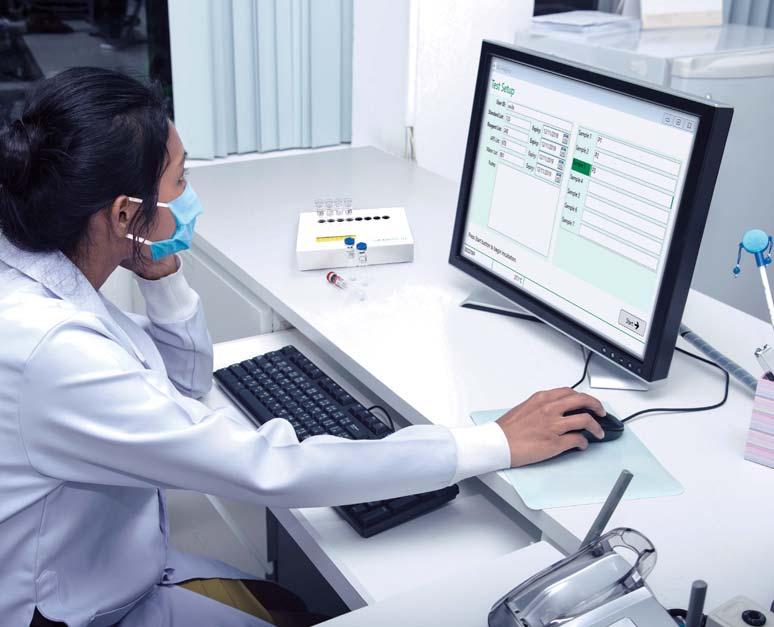


Fungitell STAT™ is the first and only single sample format FDA-cleared and CE marked rapid in vitro diagnostic screening test for IFI (including Candida, Aspergillus and Pneumocystis) that detects (1 3)- -D-Glucan in serum.
Conclusion
Successfully incorporating biosimilars into oncology practice requires education and understanding by all people involved in the medication use process. Adequate patient counseling and support when newly initiating therapy or converting to a biosimilar are critical. Pharmacists are uniquely positioned to provide clinician and patient education and will play a significant role in increasing adoption of biosimilars for cancer treatment.
References
1. FDA. Biosimilar product information:
FDA-approved biosimilar products. bit.ly/2G3Pnes-PPN. Accessed
September 28, 2020.
2. Chan A, Patel H, Siderov J, et al.
Assessing biosimilar education needs among oncology pharmacy practitioners worldwide: an ISOPP membership survey.
J Oncol Pharm Pract. 2020;26(3 suppl):11-21.
3. Cuellar S, McBride A, Medina P. Pharmacist perspectives and considerations for implementation of therapeutic oncology biosimilars in practice. Am J Health Syst
Pharm. 2019;76(21):1725-1738.
4. Foreman E, Chan A, Biosimilars Task
Force. Biosimilar implementation in clinical practice: an ISOPP collection for oncology pharmacists. J Oncol Pharm Pract. 2020;26(3 suppl 2).
5. FDA. Get email updates. https://fda.gov/ about-fda/contact-fda/get-email-updates.
Accessed September 28, 2020.
6. Hematology/Oncology Pharmacy
Association. Drug updates. https:// www.hoparx.org/table/resources/ drug-updates-from-the-fda/. Accessed
September 28, 2020.
7. Cook JW, McGrath MK, Dixon MD, et al. Academic oncology clinicians’ understanding of biosimilars and information needed before prescribing. Ther Adv Med Oncol. 2019;11:1758835918818335. doi: 10.1177/1758835918818335
8. Williamson C, Berger L, Sullivan TP, et al.
Addressing oncologists’ gaps in the use of biosimilar products. Am J Manag Care. 2019;25(6 Spec No.):SP188-SP191.
9. Zelenetz AD, Ahmed I, Braud EL, et al.
NCCN Biosimilars White Paper: regulatory, scientifi c, and patient safety perspectives.
J Natl Compr Canc Netw. 2011;9(4 suppl:
S1-S22.
10. Lyman GH, Balaban E, Diaz M, et al.
American Society of Clinical Oncology statement: biosimilars in oncology. J Clin
Oncol. 2018;36(12):1260-1265.
11. Hematology/Oncology Pharmacy
Association. Biosimilars issue brief: an important new category of medications for cancer patients. http://www.hoparx. org/images/hopa/advocacy/Issue-
Briefs/HOPA_Biosimilars_Issue_Brief. pdf. Revised December 2015. Accessed
September 28, 2020.
12. Vizgirda V, Jacobs I. Biosimilars: considerations for oncology nurses.
Clin J Oncol Nurs. 2017;21(2):E54-E60.
13. FDA. Patient materials: biosimilar basics for patients. https://www.fda.gov/drugs/ biosimilars/patient-materials. Updated March 23, 2020. Accessed September 28, 2020.





